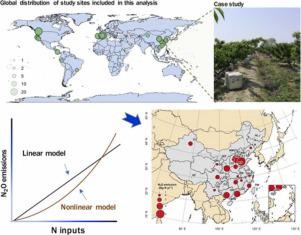Agriculture, Ecosystems & Environment ( IF 6.0 ) Pub Date : 2022-01-10 , DOI: 10.1016/j.agee.2022.107854 Pinshang Xu 1 , Zhutao Li 1 , Jinyang Wang 1, 2 , Jianwen Zou 1, 2

|
The fruit has become the third-largest agricultural planting industry after cereals and vegetables in China. Fertilization regimes (e.g., application rate and method) in fruit orchards typically differ from cereal croplands, which would incur a pronounced difference in fertilizer-induced nitrous oxide (N2O) emissions between them. However, fertilizer-induced direct N2O emissions from orchard fields remain poorly understood. We conducted a field experiment in a peach orchard and a global meta-analysis of N2O emissions from fruit orchards. The emission factor (EF) of fertilizer N for N2O averaged 0.81%, with a background N2O emission of 3.4 kg N ha–1 yr-1 in our field study. A global meta-analysis suggested that the linear regression model was the best to fit N2O emissions by fertilizer N input for most fruit types compared to the nonlinear models. When averaging all global data, the linear model projected the EF of N2O from orchards to be 0.84%, with the background emission of 1.96 kg N ha–1. The estimate of direct N2O derived from the orchard-specific nonlinear model was substantially lower than those from the nonlinear model with global cropland measurements. The fertilizer-induced direct N2O emission from Chinese orchards during the 2000s was estimated to be 32–49 Gg N yr–1, equivalent to about 14% of total direct N2O emissions from Chinese uplands. Therefore, orchard cultivation constitutes a hotspot of N2O emissions in the agricultural sector, and priority should be given to emissions reduction to achieve the transition to climate-smart agriculture.











































 京公网安备 11010802027423号
京公网安备 11010802027423号